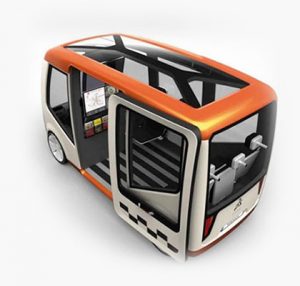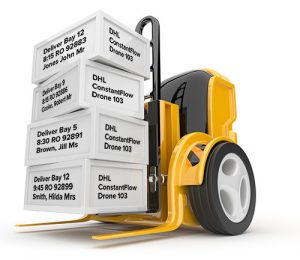Our customers at Infomedia are constantly looking out for ways to improve the productivity and efficiency of their dealership.
In this week’s blog article, we discuss how dealerships and automakers can improve their efficiency by streamlining parts operations, and how parts ordering software can improve the way service parts are managed.
“Less inventory on hand at the dealership level and a better use of logistics would improve efficiency at the OEM dealership.”
Starting from Now
 The fundamental infrastructure and logistics for handling parts inventory for workshop and retail sales is much as it was a century ago. This involves estimating a workable indent level of inventory to handle anticipated sales needs between restocking cycles, establishing resources to control stock (personnel, real-estate, money, and systems), and logistics to move it in and out of the dealership to its final usage location. Automakers and dealers recognise a real need to streamline parts operations, and their attempts to do so, recurringly cycle through various stock indenting and logistic delivery programs.
The fundamental infrastructure and logistics for handling parts inventory for workshop and retail sales is much as it was a century ago. This involves estimating a workable indent level of inventory to handle anticipated sales needs between restocking cycles, establishing resources to control stock (personnel, real-estate, money, and systems), and logistics to move it in and out of the dealership to its final usage location. Automakers and dealers recognise a real need to streamline parts operations, and their attempts to do so, recurringly cycle through various stock indenting and logistic delivery programs.
As the number and complexity of vehicles has increased over the decades, so too has the size and value of indealership resources dedicated to parts. This has only been mitigated somewhat by improvements in delivery logistics times. Some dealerships today can have more cash locked up in parts inventory than they do in new vehicle flooring, while parts are more susceptible to loss through obsolescence, theft, or misapplication.
Parts sales is seen as a profit centre in most dealerships and controlled separately from Service operations. The majority of parts departments globally, primarily support their service departments. Many parts departments do sell genuine OE parts to IMTs per enquiry, while a smaller percentage proactively operate ‘wholesale’ parts operations for trade buyers. Perhaps due to the predominant inventory control nature of Parts, their departments rarely yield control to Service personnel much less IMTs.
Vision of the Future
In 2020, dealership parts supply and logistics will be well on its way to becoming an effective and responsive ‘just in time’ (JIT) operation. Vehicle owners/users will become accustom to scheduling appointments for vehicle service and repair. Trade customers will become accustomed to ‘do it yourself’ (DIY) parts ordering. Transformations to regional distribution and logistics will deliver major productivity and sales gains throughout OE networks. As a result, dealerships will hold no stock on site, or only very fast moving small items for ad hoc needs. Faster and more sophisticated logistics processes will deliver needed parts within hours.
Vehicle users or their PDAs will book services online, while providing pre-diagnostic data streams from the vehicle and third party devices. The vehicle identification and specific pre-diagnostic data will be triangulated with other service Big Data to establish a JIT parts and special tools order that will be scheduled to arrive at the designated service bay, at the designated time. The order will include parts and special tools required for the specific booked services, as well as ones which Big Data predicts are statistically XX% probable to be identified during an on-site inspection. Such predictions will utilise specific booked vehicle history, general vehicle model-line history, regional / seasonal conditions, and personal driver habits to mention a few. At the end of the service, tools and unused parts will be pushed away from the bay and returned for credit on the next logistics run.
ITPs like Infomedia will provide new tools for dealers who also proactively pursue trade and DIY retail sales. These tools will empower these customers to schedule parts orders themselves for JIT delivery too, with orders ‘dropped shipped’ to eliminate double handling. Collectively, the changes to in-house and trade parts processing will slash the resources required and increase the level of genuine OE parts sales. The satisfaction of customers will escalate. Competitive performance against aftermarket offerings will rocket both in absolute and relative terms.
“Another reason why I think the relationships [between parts and service] will get stronger, is because your car is going to tell us what it needs and when it needs it and the automaker is going to make sure the parts are at the dealership before the car gets there. And that’s going to be quite hard for independents to compete with.”
Bridge to the Future
 Technology will enable this dramatic shift in the way service parts are managed. Vehicles will increasingly be fitted with telematics that support automated service pre-planning. Telemetric information and other Big Data will allow the parts catalogues of online booking systems to automatically interpret and reserve parts, special tools, and consumables. The correct parts will be ordered and delivered to dealerships before the vehicle arrives for a service or repair.
Technology will enable this dramatic shift in the way service parts are managed. Vehicles will increasingly be fitted with telematics that support automated service pre-planning. Telemetric information and other Big Data will allow the parts catalogues of online booking systems to automatically interpret and reserve parts, special tools, and consumables. The correct parts will be ordered and delivered to dealerships before the vehicle arrives for a service or repair.
Economic benefits will drive organisational changes within dealerships that bring Parts and Service much closer together. These will also drive implementation of automation tools that distribute parts interpretation and ordering tasks to the part customer and to smarter automated systems.
In time, 24/7 ‘autonomous delivery’ will be possible through the use of driverless-vehicles. The tyranny of time, distance and human-driver limitations will give way to a continuous flow of logistic delivery movements to customers for JIT delivery, and from customers with unused JIT components for credit.
Very decentralised logistics will power the parts supply chain with parts customers receiving orders several times a day. The industry will benefit from the logistics revolution already underway in consumer retailing, as epitomised by Amazon.com. The need for stocking parts at the dealership will fall away in direct proportion to this transformation in handling logistics and customer engagement systems. This revolutionises dealership Aftersales economics and opportunities.
